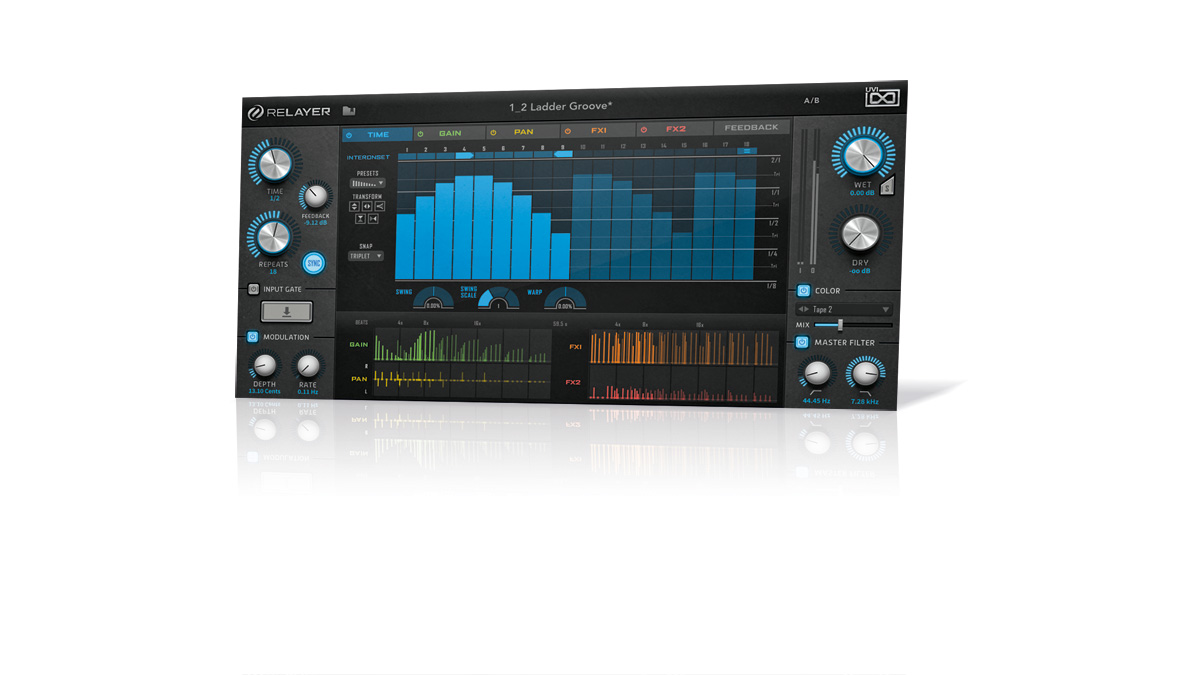MusicRadar Verdict
A fun, interesting and highly creative delay-based plugin that treads its own path and is all the more impressive for it.
Pros
- +
Slick, fun interface. Step sequencer presets for quick setup. Excellent real-time delay.
Cons
- -
No tap pad.
MusicRadar's got your back
UVI calls Relayer (VST/AU/AAX) a "Precision Creative Delay"; more specifically, it's a 32-tap delay processor with modulation and additional effects.
It centres on a step sequencer, with five Editor pages for applying per-tap modulation to delay Time, Gain, Pan, FX1 and FX2 parameters. Those 'FX' are identical processors with six modes to choose from: Biquad, Comb, Vowel, Wahwah, Redux and WaveShaper. For these, the step values pertain to one specific parameter of the selected effect.
Relayer's sixth page handles global feedback settings, including High and Low Pass filtering, Drive, Drive Type (Analog, Tape and Tube) and specifying which tap has feedback applied. These tie in with the global Feedback setting on the left, next to which the Repeats control sets the number of delay taps.
The Time knob above sets a time division in milliseconds or beats (1ms to 2s or 1/64 triplets to 32 beats), and delay times in the modulation sequencer are set to a multiple or division of this.
Below these are the global delay Modulation Depth and Rate controls, and the Input Gate on/ off and trigger buttons, the latter used to momentarily send the input signal into the processor.
On the right are further global parameters, comprising separate Dry and Wet levels, Color (a 66-preset impulse response processor), and a wet signal Master Filter, with adjustable High and Low Pass controls.
Just below the modulation sequencer sits the Visualizer. This handy graphical display gives real-time feedback on the Gain, Pan, FX1 and FX2 parameters, including the effects of global Feedback and the LFOs within FX1 and FX2.
Want all the hottest music and gear news, reviews, deals, features and more, direct to your inbox? Sign up here.
Simple yet complex
Drawing in values in the modulation sequencer is straightforward, but each tab also includes a collection of parameter-specific Preset shapes to get you started. Values can also be adjusted collectively using the Transform function.
Mod Range markers along the top of each Editor enable looping of parameter settings, and Mod Ranges are totally independent of each other, so you can combine, say, a short loop for one parameter with lengthier loops elsewhere.
Further parameters in the Time and Pan Editors are Swing and logarithmic Warp for Time, and overall Width for Pan, which delays one channel slightly (0-10ms). Advanced FX parameters depend on the loaded effect (filter Mode for Biquad and Model for Wahwah, for example), and the sequenced parameter can also be modulated with FX-specific LFOs.
Ultimately, it's in the FX sections that Relayer comes into its own. By combining them with the varied selection of IRs in the Color processor (including rooms, amps, speakers and assorted other devices) some awesome sounds can be cooked up.
The silky smooth Biquad filter and the potentially aggressive WaveShaper are particularly impressive. And should things get out of control, the vast majority of Relayer's sections and functions, including the tabbed Editors, can be independently bypassed.
Every multitap delay plugin has its own modus operandi, and Relayer is no exception. Entering delay times - particularly unsynced - takes a bit of getting used to, as you have to think in terms of multiples of the global Time setting, and there's no manual delay tap entry pad.
For the most part, though, the interface is a joy to use, with excellent visual feedback, and an abundance of useful features. Relayer delivers everything from simple delays to complex, warped effects with aplomb, and it's already become a go-to in our list of creative plugins.
Computer Music magazine is the world’s best selling publication dedicated solely to making great music with your Mac or PC computer. Each issue it brings its lucky readers the best in cutting-edge tutorials, need-to-know, expert software reviews and even all the tools you actually need to make great music today, courtesy of our legendary CM Plugin Suite.

